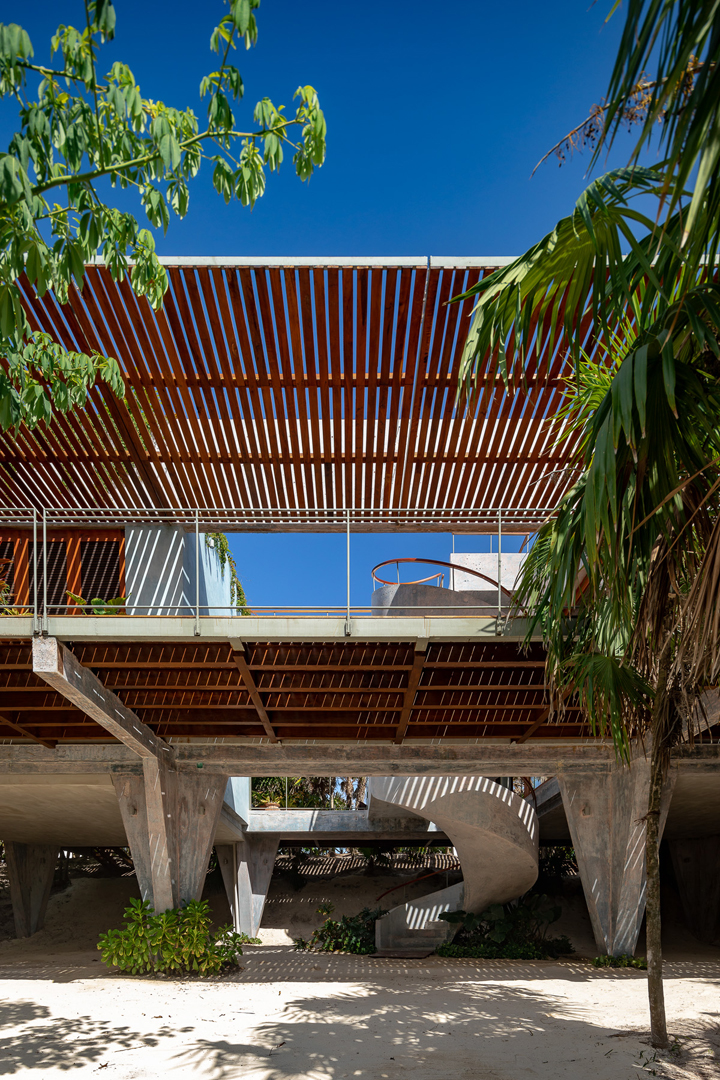Bautista House
2019 - Quintana Roo, Mexico

The project was developed on a narrow beachfront lot on the Riviera Maya, near Tulum, in Quintana Roo, and is fully powered by solar and wind energy. The entire project was cast in an organic blue color concrete, which reacts over time according to its exposure to the sun and its position in the house, creating tones that range from ocean blue to sunset pink.
By raising the house on cross-shaped columns, the impact on the environment is reduced and views are generated over the dune that separates the property from the sea. The project is organized on three levels that are connected by a spiral staircase: the auxiliary ground floor below the house, the intermediate level containing all interior spaces, and a large roof terrace with a pool and an outdoor dining room presenting views of the Caribbean sea, the jungle, and the lagoon. Close to the master bedroom, a distinct turret is situated: it works as a formal element that anchors the ensemble into place and doubles as a flexible space for work or meditation.
The intermediate L-shaped floor plan extends beyond the ground floor through large terraces and pergolas made with local wood. In this way, the interior spaces are enlarged and protected from the sun; and good cross ventilation is achieved (only the bedrooms have an air conditioning system). These terraces have a folding mechanism that protects the house in the event of hurricanes: by raising and lowering these heavy elements against the facade, the open and transparent residence is transformed into a robust closed box.
















Architecture: PRODUCTORA (Carlos Bedoya, Victor Jaime, Wonne Ickx, Abel Perles) | Collaborators: Alejandro Ordoñez, Josue Palma, Daniela Dusa, Antonio Espinoza, Gerardo Aguilar | Structural engineering: Kaltia | Mechanical engineering and sustainability: EOS | Landscape: Planta | Type: Residential | Location: Quintana Roo, Mexico | Surface: 3229 sqft | Client: Ezequiel Ayarza | Date: 2019 | Photography: Onnis Luque
- Winner of Wallpaper Award 2020: Best Retreat
- Peninsula III Award (2020): Residential Architecture Category - First Prize
- A’N Best of Design Awards 2020: Single-Unit Residential Category – First Place
- Mexico's City Biennial of Architecture 2021, Residential Category, Casa Bautista - Silver Medal
Note: The Sian Ka'an biosphere was established in 1986 and became a UNESCO World Heritage Site in 1987. The reserve is divided into three areas. In the first area or 'Core Area’ human activities are strictly restricted to protect the natural reserves and the indigenous territories. Only researchers can access these areas with special permits. The second area is called the ‘Buffer Zone’. The buffer zones are used for cooperative activities that complement sound ecological practices. The third area is the 'Transition Zone’: an area with the highest degree of human intervention and transit. Sustainable development is the focus of the transition area, where local residents, economic interests, scientists, management agencies and non-government organizations work together linking conservation and economic development (UNESCO, 2012b). In this area a limited number of constructions can be build: these have to obey to a very strict set of regulations in terms of sustainability during construction and operation. It is in this Transition Zone that the Bautista House is realized.
There are 580 UNESCO Biosphere Reserve sites in 114 countries, with many of these reserves providing for tourism and sustainable development: the Sian Ka'an Biosphere Reserve in Mexico is regarded as one of the flagships of the UNESCO MAB program for eco-tourism.



